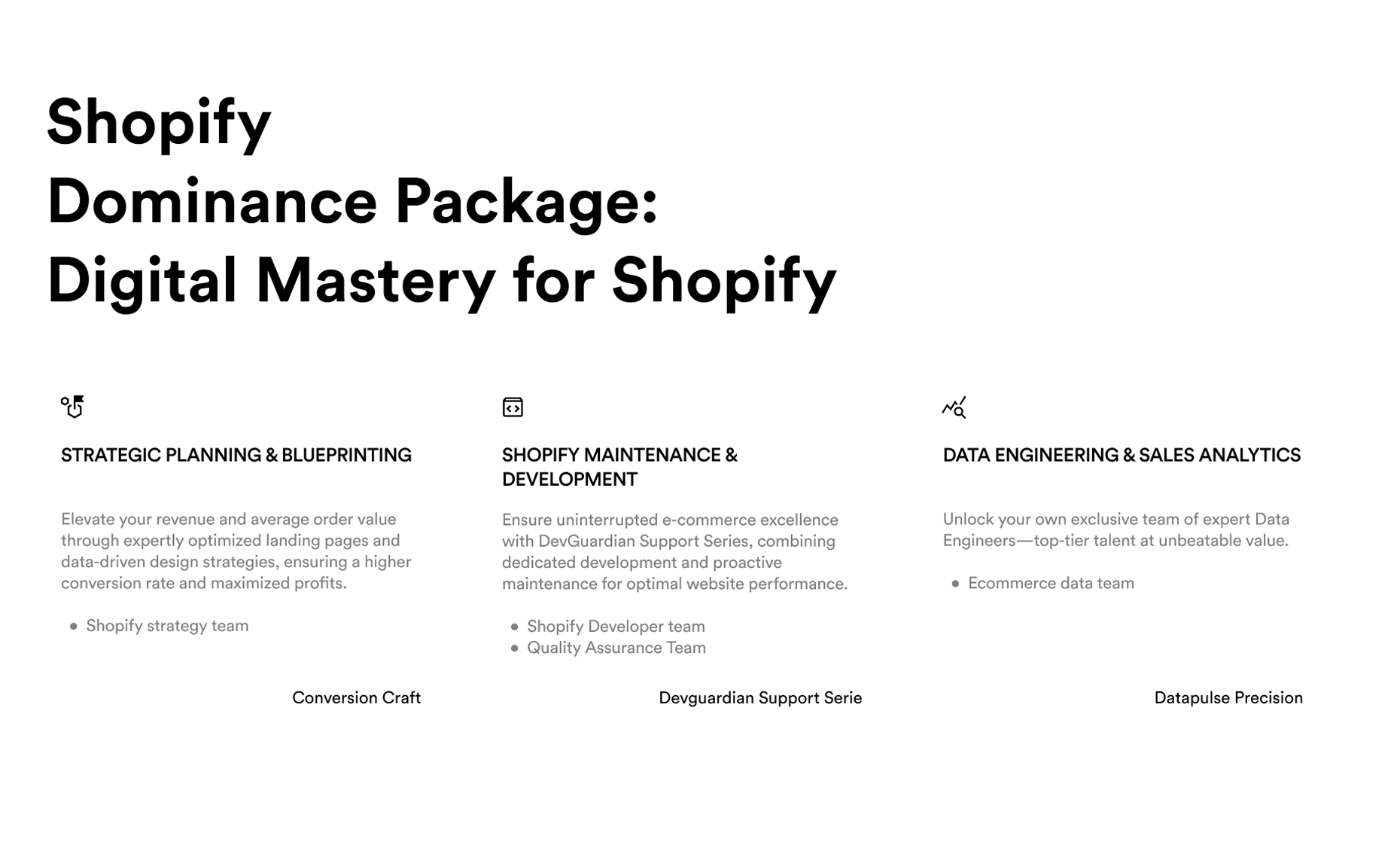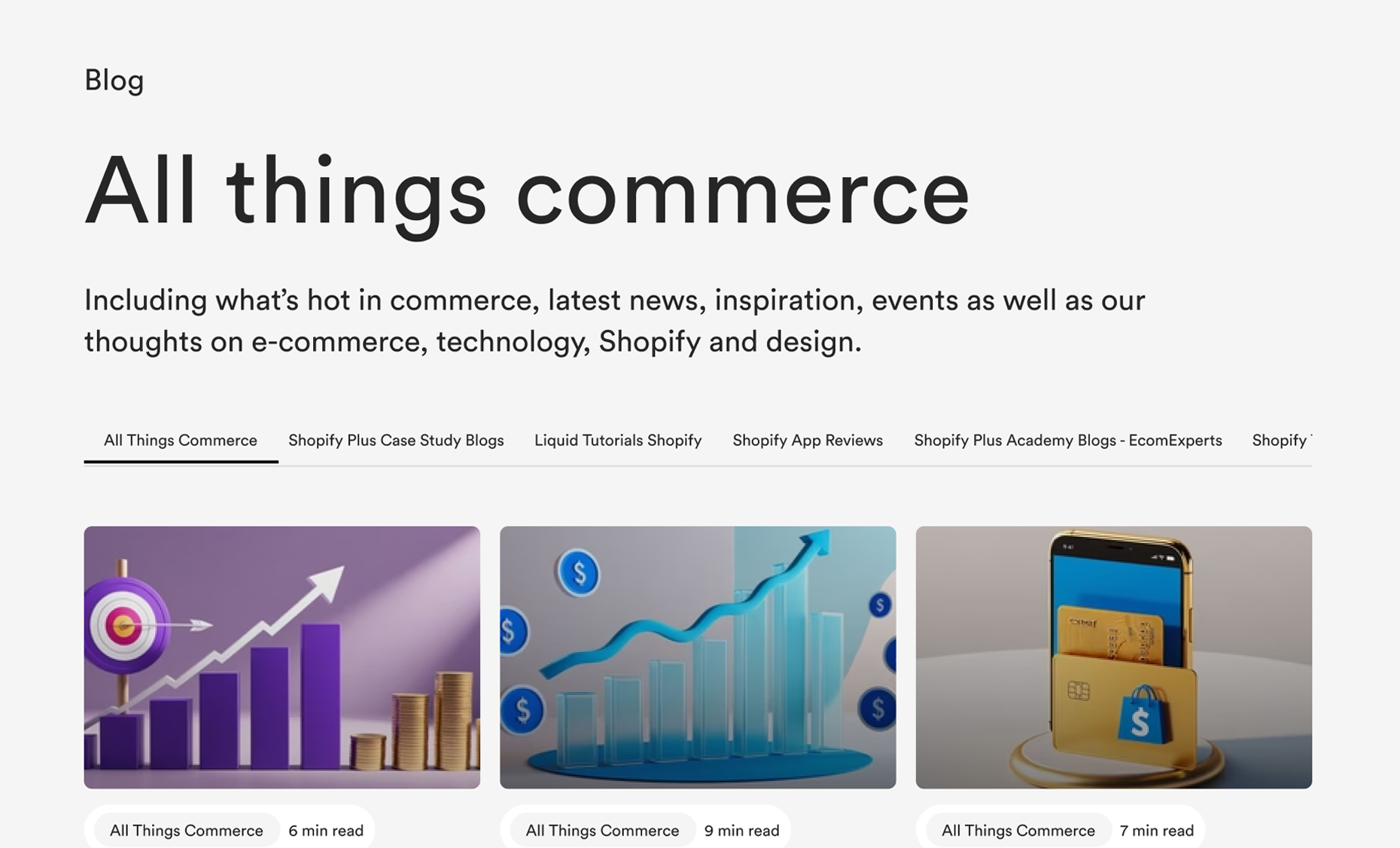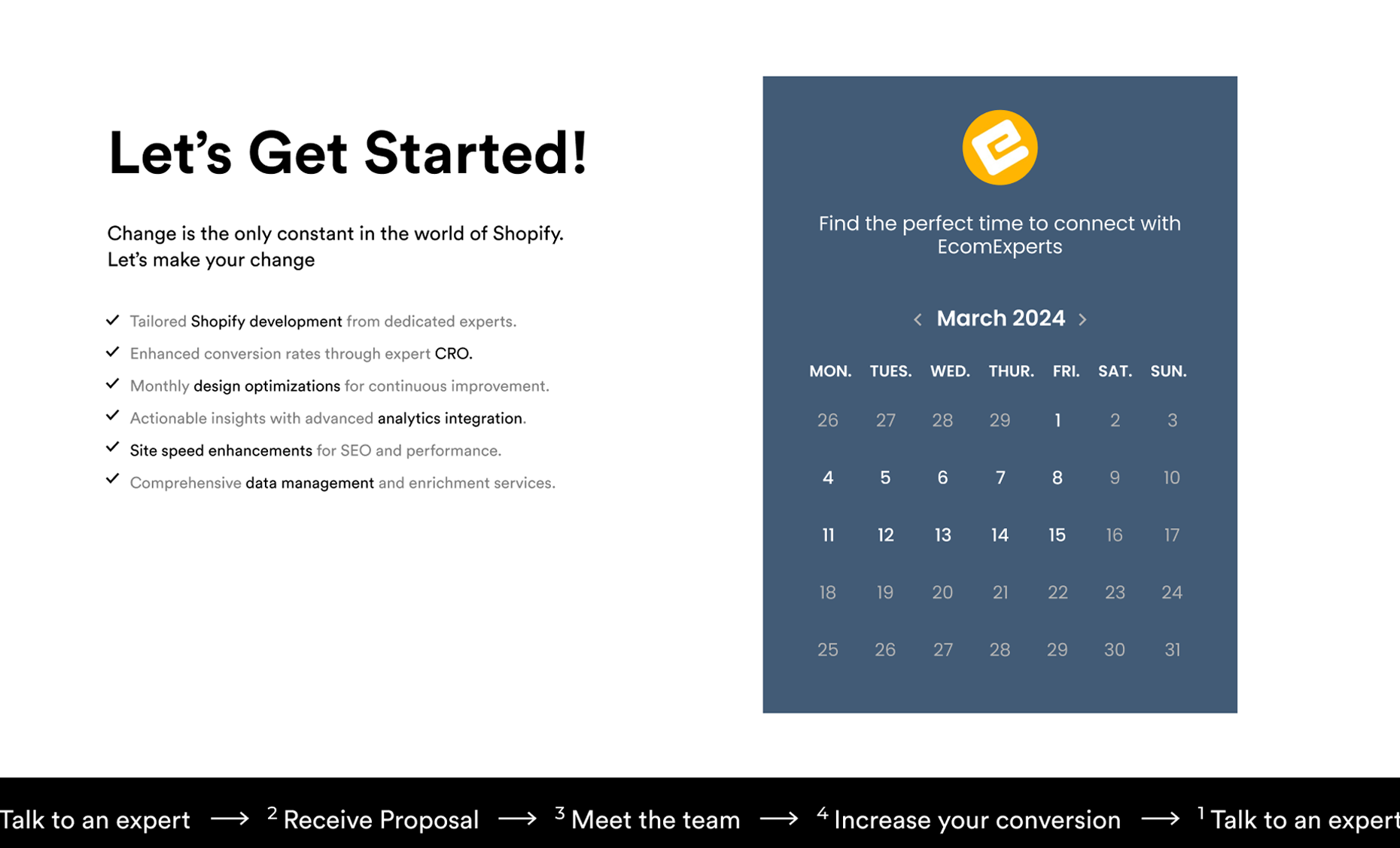Let’s get straight to the point—2024 is the year you either automate your Shopify store or risk being left behind.
Customers demand speed, personalization, and seamless experiences, and if you’re not delivering, they’re bouncing to your competitors faster than you can say “conversion rate.”
That’s where automation comes in. But we’re not just talking about any automation; we’re talking about smart, efficient, and targeted automation that transforms your Shopify store from just another online shop into a well-oiled e-commerce machine.
Why You Need to Automate Your E-Commerce Store
If you’ve been running a Shopify store for any length of time, you already know that e-commerce isn’t just about setting up a site and waiting for the sales to roll in. It’s about staying ahead of trends, managing inventory, fulfilling orders, engaging with customers, and so much more.
In 2024, the need for automation is not just a luxury; it’s an absolute necessity. Why? Because the pace of online shopping in North America has accelerated to a point where manual processes simply can’t keep up.
In the USA and Canada, customers have grown accustomed to the Amazon standard—two-day shipping, personalized recommendations, and lightning-fast customer service. This is the bar now, and anything less feels like a letdown.
To meet these expectations, Shopify store owners need to automate repetitive tasks like order processing, customer segmentation, and even some aspects of customer service. This frees you up to focus on the bigger picture: scaling your business, creating better customer experiences, and driving more sales.
How Automation Transforms Shopify Stores in 2024
Let’s be real—if you’re not automating key aspects of your Shopify store, you’re probably drowning in a sea of to-do lists, missed opportunities, and frustrated customers.
Automation isn’t just about saving time (though that’s a huge benefit); it’s about transforming the way you run your business. Imagine having a virtual team that never sleeps, constantly working in the background to optimize your store, engage your customers, and keep your operations running smoothly.
In 2024, automation tools for Shopify have become incredibly sophisticated. We’re talking about apps that can manage everything from personalized email marketing campaigns to subscription billing, and even complex shipping logistics.
These tools don’t just automate tasks—they enhance them. For instance, automation can help you segment your email lists with pinpoint accuracy, ensuring that each customer receives content that’s highly relevant to their shopping habits. It’s like having a personal shopper for each of your customers, but without the overhead.
For Shopify store owners, consumer expectations are sky-high which makes this level of automation crucial. It’s not just about doing things faster; it’s about doing them better. Automation allows you to offer the kind of personalized, efficient service that today’s customers expect, all while keeping your operational costs in check.
Why Every Shopify Store Needs Automation Tools
Here’s the deal: If you’re running a Shopify store in 2024 without leveraging automation tools, you’re leaving money on the table—plain and simple. Automation tools are no longer optional; they’re essential for survival in a competitive e-commerce market.
Whether you’re a one-person operation or a growing team, automation tools allow you to do more with less. They help you scale without sacrificing quality, which is key when you’re trying to build a brand that stands out in the crowded North American market.
Think about it—automation tools handle the grunt work, from managing inventory to processing orders and even engaging customers with personalized marketing. This means you can focus on what you do best: growing your business.
And in 2024, with the rise of AI and machine learning, these tools are smarter than ever. They’re not just automating tasks; they’re learning from your data, making recommendations, and optimizing your processes in real-time.
So, whether you’re aiming to increase your customer lifetime value, reduce cart abandonment, or simply keep up with the ever-increasing demands of the modern consumer, automation is your answer.
And for Shopify store owners, these tools are the key to staying competitive, driving sales, and scaling your business in a market that’s more dynamic and demanding than ever before.
Overview of E-commerce Automation
Let’s talk about what automation really means in the world of e-commerce in 2024. If you’re still manually managing key aspects of your Shopify store, it’s time for a serious upgrade.
Automation is no longer just a tool; it’s the backbone of modern e-commerce operations, especially in competitive markets. But what does automation truly entail, and why is it so crucial? Let’s break it down.
Shopify Store Automation in 2024
Automation in e-commerce refers to the use of software and apps to execute repetitive tasks and processes without the need for human intervention. This could include anything from processing orders, managing inventory, personalizing marketing campaigns, to handling customer service inquiries.
In 2024, automation isn’t just about efficiency; it’s about creating a seamless, personalized, and highly responsive shopping experience that today’s consumers demand.
Here’s the thing—automation directly impacts your bottom line. In a market where customer expectations are sky-high, particularly in regions like the USA, UK, and Canada, the ability to deliver fast, accurate, and personalized service is what sets successful Shopify stores apart from the rest.
Automation tools help you scale your operations without compromising on quality, allowing you to handle more orders, engage more customers, and manage more inventory with the same resources.
How Automation Drives Growth and Efficiency
Automation is a growth driver. Period. If you’re looking to scale your Shopify store, automation is not just an option—it’s a necessity. By automating routine tasks, you free up your time and your team’s time to focus on strategic initiatives like product development, customer engagement, and market expansion.
This is particularly crucial in the North American market, where competition is fierce and customer loyalty is hard-won.
Efficiency is the name of the game when it comes to e-commerce automation. By automating processes like order fulfillment, marketing, and inventory management, you can reduce errors, speed up processes, and improve accuracy—all of which contribute to a better customer experience.
And in 2024, with advances in AI and machine learning, automation tools are more powerful and intuitive than ever, allowing you to optimize your operations in real-time based on customer data and behavior.
But it’s not just about working faster—it’s about working smarter. Automation tools can analyze your customer data to identify trends, predict demand, and even personalize the shopping experience for each visitor to your site.
This level of personalization is what today’s customers expect, and it’s what will keep them coming back to your store.
Key Areas Where Automation is Essential
Now, let’s get into the specifics. Where does automation have the most impact in your Shopify store? Here are the key areas:
1. Order Processing
When a customer places an order, they expect it to be processed quickly and accurately. Automation tools can handle everything from order confirmation emails to updating inventory levels and even printing shipping labels.
This not only speeds up the process but also reduces the risk of human error, ensuring that your customers receive their orders on time, every time.
2. Marketing
Personalized marketing is critical in today’s e-commerce landscape. Automation tools can segment your customer base, send personalized email campaigns, and even retarget customers who have abandoned their carts.
With the ability to automate marketing tasks, you can engage with your customers in a more meaningful way without adding to your workload.
3. Inventory Management
Keeping track of inventory manually is a recipe for disaster, especially when you’re dealing with multiple sales channels. Automation tools can track inventory levels in real-time, automatically reorder stock when levels are low, and even forecast demand based on historical sales data.
This ensures that you always have the right products in stock, minimizing the risk of stockouts or overstocking.
4. Customer Service
Customer service is another area where automation can make a huge difference. Chatbots, for example, can handle routine inquiries, provide instant responses, and even guide customers through the purchasing process.
This not only improves the customer experience but also frees up your customer service team to handle more complex issues.
5. Shipping and Fulfillment
Automating your shipping and fulfillment processes can save you time and money. Tools can automatically select the best shipping option based on the customer’s location, print shipping labels, and even track packages in real-time.
This ensures that your orders are shipped quickly and accurately, which is crucial for customer satisfaction.
6. Customer Retention
Automation isn’t just about getting new customers—it’s about keeping the ones you already have. Tools that automate customer retention strategies, such as loyalty programs, personalized offers, and follow-up emails, can help you build long-term relationships with your customers, increasing their lifetime value and boosting your bottom line.
In 2024, the e-commerce giants aren’t just using automation—they’re mastering it. The tools available today are more sophisticated than ever, allowing you to automate almost every aspect of your business.
And the best part? These tools are accessible to businesses of all sizes, so whether you’re just starting out or you’re scaling up, automation can give you the edge you need to succeed.
By automating these key areas of your Shopify store, you’re not just saving time—you’re creating a smoother, more efficient, and more profitable business that’s built to thrive in the fast-paced world of e-commerce.
Choosing the Right Shopify Automation Apps
Alright, let’s get down to brass tacks. Choosing the right automation apps for your Shopify store isn’t just about picking the most popular ones off the shelf—it’s about finding the tools that align perfectly with your specific business needs.
In the fast-paced e-commerce landscape, the right app can be a game-changer, while the wrong one can set you back. So, how do you make the right choice? Let’s break it down.
What to Look For in Automation Tools
When you’re on the hunt for the best automation apps, there are a few key factors you need to consider. These aren’t just nice-to-haves—they’re non-negotiables that will determine whether an app will actually deliver the results you need.
1. Ease of Use
First things first, the app needs to be user-friendly. You don’t want to spend hours trying to figure out how to use a tool when you could be focusing on growing your business.
Look for apps that have a clean, intuitive interface and offer robust support, whether that’s through tutorials, customer service, or a helpful community of users. Remember, automation is supposed to save you time, not create more headaches.
2. Integration
Your Shopify store likely has a host of other apps and tools running behind the scenes, from payment gateways to marketing platforms. The automation app you choose must integrate seamlessly with these tools.
Check whether the app is compatible with your existing tech stack, including Shopify’s own built-in features. The more smoothly it integrates, the less you’ll have to worry about compatibility issues down the road.
3. Pricing
Let’s be real—budget matters. While you might be tempted to go for the cheapest option, remember that you get what you pay for. Instead of focusing on the upfront cost, think about the value the app will bring to your business in the long run.
Does it offer a free trial? What’s included in the pricing tiers? And most importantly, does the ROI justify the cost? In markets like the USA and Canada, where operational costs can be high, getting the best bang for your buck is essential.
4. Scalability
Your business is going to grow—at least, that’s the plan, right? The app you choose needs to grow with you. Scalability is crucial. You need to ensure that the app can handle increased traffic, more orders, and more complex processes as your store expands.
Look for tools that offer features like tiered pricing or the ability to add more users, integrations, or features as needed.
Common Pitfalls to Avoid When Selecting Apps
Let’s face it—there are a lot of shiny objects out there in the world of Shopify apps, and it’s easy to get distracted. But here’s the thing: not every app is created equal, and making the wrong choice can cost you big time. Here are some common pitfalls to avoid:
1. Overcomplicating Your Stack
More apps don’t always equal better results. In fact, overloading your store with too many tools can slow it down, create conflicts between apps, and make your backend a nightmare to manage. Focus on quality over quantity. Choose apps that offer multi-functionality, so you can keep your stack lean and mean.
2. Ignoring User Reviews and Feedback
In the rush to get an app up and running, it’s easy to skip over the reviews. But user feedback is gold—especially from those who have similar businesses to yours. Look for patterns in the reviews.
Are multiple users complaining about the same issues? Is customer support responsive? Take the time to do your research, and don’t just rely on the app’s sales page to make your decision.
3. Neglecting to Test Before Committing
Most apps offer a free trial or a demo. Use it. Testing an app in your live environment is crucial to ensure it works as advertised and integrates well with your existing tools.
Don’t rush into a paid plan without giving the app a thorough test run. This is especially important if the app handles critical functions like payment processing or inventory management.
Why the Right App Can Make or Break Your Automation Strategy
Here’s the bottom line: the automation tools you choose will either propel your business forward or hold it back. The right app can streamline your operations, reduce errors, and free up your time to focus on growth. On the flip side, a poorly chosen app can create bottlenecks, frustrate your team, and lead to missed opportunities.
When you choose the right tools, you’re not just automating tasks—you’re building a robust infrastructure that supports your business’s long-term growth. And that’s how you turn your Shopify store from a side hustle into a thriving e-commerce powerhouse.
Top 7 Shopify Apps to Automate Your E-commerce Store in 2024
Automation is no longer a luxury in e-commerce; it’s a necessity. With the right tools, you can streamline operations, improve customer experience, and free up time to focus on scaling your business.
Here are the top seven Shopify apps you need in 2024 to automate your store and stay ahead of the competition.
1. Shopify Flow

Overview and Features:
Shopify Flow is a powerful automation tool built directly into Shopify that allows you to create custom workflows without any coding. It’s designed to automate tasks across your Shopify store, such as inventory management, order processing, customer segmentation, and marketing campaigns.
The app offers a drag-and-drop interface to set up triggers, conditions, and actions, making it easy to automate repetitive tasks.
Best Use Cases:
- Automating Manual Processes: Use Shopify Flow to automate routine tasks like tagging high-value customers, sending reorder alerts, or notifying teams about low stock levels.
- Streamlining Operations: Automatically cancel fraudulent orders, track inventory across multiple locations, or trigger emails based on customer behavior.
2. Zapier

Overview and Features:
Zapier is the Swiss Army knife of automation, connecting Shopify to over 2,000 other apps. With Zapier, you can create "Zaps" to automate workflows between Shopify and other platforms like Google Sheets, Slack, Mailchimp, and more.
It’s all about connecting your tools and automating tasks that span multiple apps.
Best Use Cases:
- Connecting Shopify to Various Platforms: Automatically update a Google Sheet with new Shopify orders, send customer details to your CRM, or trigger Slack notifications when a sale is made.
- Streamlining Cross-Platform Operations: Create multi-step workflows that connect Shopify with your accounting software, email marketing tools, and project management apps.
3. Klaviyo

Overview and Features:
Klaviyo is a powerhouse in automated email marketing, offering robust segmentation and personalized email campaigns tailored to each customer’s behavior.
With Klaviyo, you can automate everything from welcome series to abandoned cart reminders and post-purchase follow-ups. Its deep integration with Shopify means you can leverage all your store data to create highly targeted email campaigns.
Best Use Cases:
- Automated Email Marketing: Send personalized emails based on customer behavior, such as browsing history, past purchases, or engagement with previous emails.
- Segmentation: Automatically segment your email list into groups based on specific criteria like purchase frequency, average order value, or product preferences.
4. Omnisend

Overview and Features:
Omnisend takes multichannel marketing automation to the next level. It allows you to automate email, SMS, and push notifications all from one platform.
With Omnisend, you can create comprehensive marketing workflows that cover every touchpoint in the customer journey, ensuring consistent messaging and maximizing engagement.
Best Use Cases:
- Multichannel Marketing Automation: Automate campaigns across email, SMS, and push notifications to create a unified customer experience.
- Customer Retention: Use automated workflows to re-engage customers who haven’t made a purchase in a while or to upsell and cross-sell products based on past behavior.
5. Order Printer

Overview and Features:
Order Printer is a must-have for any Shopify store that deals with high volumes of orders. This app automates the process of generating invoices, packing slips, and custom order documents.
It’s fully customizable, allowing you to create templates that fit your brand’s style and meet your specific needs.
Best Use Cases:
- Automated Invoicing: Automatically generate and send invoices to customers as soon as an order is placed.
- Order Processing Efficiency: Streamline your packing and shipping process by printing packing slips and shipping labels in bulk.
6. ReCharge

Overview and Features:
ReCharge is the go-to app for managing subscription services on Shopify. Whether you’re selling subscription boxes, digital memberships, or recurring services, ReCharge automates the entire process, from billing to fulfillment.
It’s designed to simplify subscription management, making it easy for customers to manage their subscriptions directly from your store.
Best Use Cases:
- Subscription Management Automation: Automate billing, shipping, and customer notifications for subscription products.
- Customer Retention: Use ReCharge’s built-in tools to offer flexible subscription options, such as pausing or skipping shipments, which can reduce churn and improve customer satisfaction.
7. Stock Sync

Overview and Features:
Stock Sync is an essential app for any Shopify store with a large inventory or multiple suppliers. It automates inventory management by syncing your Shopify store with suppliers, warehouses, and other sales channels.
Whether you’re managing hundreds of SKUs or just a few, Stock Sync ensures that your inventory is always up-to-date, preventing overselling and stockouts.
Best Use Cases:
- Inventory Management Automation: Automatically update stock levels across all your sales channels, reducing the risk of overselling or running out of stock.
- Supplier Integration: Sync your store with suppliers to automate restocking and keep your inventory levels optimized.
How to Implement Automation Tools in Your Shopify Store
So, you’ve decided to level up your Shopify store with some killer automation apps. That’s a smart move. But let’s be real—just downloading an app won’t magically transform your business. You’ve got to implement these tools strategically to see real results. Here’s how to do it, step-by-step, without disrupting your operations.
Step-by-Step Guide to Installing and Configuring Shopify Apps
1. Start with a Clear Goal in Mind
Before you dive into installing apps, get clear on what you want to achieve. Are you looking to streamline order processing, automate your marketing, or improve customer retention? Knowing your goals will help you choose the right apps and configure them to meet your needs.
2. Install the App from the Shopify App Store
Once you’ve identified the apps that align with your goals, head over to the Shopify App Store. Search for the app, and click on “Add app.” Follow the prompts to install it on your store.
For example, if you’re installing Shopify Flow to automate your store’s workflows, just search for it, click “Add app,” and it’ll integrate directly with your Shopify admin panel.
3. Configure the App Settings
Each app will have its own setup process. Let’s take Klaviyo as an example. After installation, you’ll need to sync it with your Shopify store, import your customer data, and set up your email flows.
Most apps offer a guided setup process, but don’t rush through it. Take the time to configure each setting according to your specific needs.
4. Test the App Functionality
Once your app is set up, run a few tests to make sure it’s working as expected. If you’re using Zapier to connect Shopify with Google Sheets, for instance, try adding a few test orders to see if they’re automatically logged into your spreadsheet. Testing is crucial to ensure that everything runs smoothly when you go live.
5. Monitor and Adjust
After your app is live, keep an eye on its performance. Use the app’s analytics or your Shopify dashboard to monitor its impact. If you’re using Omnisend for multichannel marketing, check your campaign performance regularly and tweak your workflows as needed to optimize results.
Tips for Seamless Integration Without Disrupting Your Operations
1. Start Small
If you’re new to automation, don’t try to implement all seven apps at once. Start with one or two critical tools and get comfortable with them before adding more.
For instance, begin with Shopify Flow to automate your order processing, and once that’s running smoothly, add Klaviyo for email marketing.
2. Use Sandbox Environments
If possible, use a sandbox or staging environment to test new apps before deploying them on your live store. This allows you to catch any potential issues without affecting your customers.
For example, ReCharge might work differently depending on how your store is set up, so testing it in a sandbox first can prevent unexpected disruptions.
3. Backup Your Data
Before integrating any new app, make sure you’ve backed up your store data. Apps like Stock Sync can automate inventory management, but any misconfiguration could lead to stock discrepancies.
Having a backup ensures that you can restore your store to its original state if something goes wrong.
4. Communicate with Your Team
If you have a team managing your store, keep them in the loop about new tools and workflows. Make sure they understand how the new apps work and how they’ll impact daily operations.
For instance, if you’re automating order printing with Order Printer, your fulfillment team needs to know how to use the new system.
Avoiding Common Implementation Mistakes
1. Overloading Your Store with Apps
It’s tempting to install every app that promises to make your life easier, but too many apps can slow down your site and create conflicts. Prioritize apps that offer the most value and consider combining functionalities.
For example, Omnisend can handle both email and SMS marketing, reducing the need for separate apps.
2. Ignoring App Updates
Developers frequently update apps to fix bugs, improve performance, and add new features. Ignoring these updates can lead to security vulnerabilities or compatibility issues. Set a regular schedule to check for and apply updates.
3. Neglecting to Customize Workflows
Many apps come with default settings or pre-built workflows, but don’t just set it and forget it. Customize the app to fit your specific business needs.
For instance, with Shopify Flow, you might need to adjust the workflow triggers to better align with your store’s unique processes.
4. Failing to Track Results
Automation is meant to save you time and boost efficiency, but if you’re not tracking the results, you won’t know if it’s working. Use analytics tools within each app, like the reporting features in Klaviyo or the real-time monitoring in Zapier, to measure success and make data-driven adjustments.
By following these steps, you can integrate automation tools into your Shopify store without missing a beat. The right apps, implemented strategically, will not only streamline your operations but also free up your time to focus on what really matters—growing your business.
The Future of E-commerce Automation
So, you’ve got your Shopify store running like a well-oiled machine, but here’s the thing: automation in e-commerce isn’t static. The tools you’re using today are going to evolve, and the future is going to bring even more game-changing innovations. The question is, are you ready to adapt and stay ahead of the curve?
Emerging Trends and Technologies
The e-commerce landscape is moving fast, and automation is no exception. Let’s break down some of the emerging trends and technologies that are going to reshape the way you run your Shopify store in the near future.
1. Artificial Intelligence (AI) and Machine Learning
AI and machine learning aren’t just buzzwords—they’re becoming integral to how businesses operate online. In 2024 and beyond, expect AI to drive more personalized shopping experiences, predictive analytics, and customer support automation.
- Personalized Shopping Experiences: AI-driven tools like recommendation engines are getting smarter, offering more tailored product suggestions based on a customer’s behavior, preferences, and purchase history. Imagine an AI that knows exactly what your customers want before they even do, boosting your conversion rates.
- Predictive Analytics: Machine learning algorithms can analyze vast amounts of data to predict future trends, customer behavior, and inventory needs. For instance, Shopify stores could use predictive analytics to forecast demand for products during peak seasons, optimizing inventory levels and reducing the risk of stockouts.
- AI-Powered Customer Support: Chatbots are evolving into more sophisticated AI-driven assistants that can handle complex customer queries, provide personalized support, and even upsell products based on real-time data.
2. Predictive Analytics for Smarter Decision-Making
Predictive analytics isn’t just about crunching numbers—it’s about making data-driven decisions that can drastically improve your store’s performance.
These tools analyze historical data to predict future outcomes, helping you optimize everything from inventory management to marketing campaigns.
- Marketing Optimization: Predictive analytics can identify which marketing strategies are likely to be the most effective, allowing you to allocate your budget more efficiently. This means you can focus on the campaigns that are most likely to drive sales, rather than wasting resources on ineffective tactics.
- Inventory Forecasting: By predicting which products will be in demand, predictive analytics helps you manage your inventory more effectively. This is especially important during peak seasons like Black Friday, where accurate forecasting can prevent stockouts and lost sales.
3. Automation in Logistics and Fulfillment
The future of e-commerce automation isn’t just about what happens online—it’s also about what happens behind the scenes. Automation in logistics and fulfillment is going to become increasingly important as businesses scale.
- Automated Warehouses: Companies like Amazon have already set the standard with automated warehouses that use robots to pick, pack, and ship products. This technology is becoming more accessible to smaller businesses, allowing them to scale without dramatically increasing labor costs.
- Smart Shipping Solutions: Integration of AI in shipping can help optimize delivery routes, reduce shipping times, and even predict the most cost-effective shipping methods based on real-time data. This not only saves money but also improves customer satisfaction by getting products to their destination faster.
How These Trends Will Shape the Future of Shopify Automation
These emerging technologies aren’t just cool innovations—they’re going to redefine what’s possible for your Shopify store. Here’s how they’re going to shape the future of e-commerce automation:
1. Enhanced Customer Experience
As AI and machine learning tools become more sophisticated, the customer experience will become more personalized and seamless. Imagine a Shopify store where every customer interaction—from product recommendations to customer support—is tailored to individual preferences and needs.
This level of personalization will lead to higher customer satisfaction, loyalty, and ultimately, more sales.
2. Smarter Operations
With predictive analytics and AI, you’ll be able to run a more efficient operation. By automating everything from inventory management to marketing, you’ll free up time to focus on strategy and growth.
Plus, you’ll have the data-driven insights you need to make smarter decisions, helping you stay ahead of the competition.
3. Scalable Growth
Automation is key to scaling your business without exponentially increasing your workload. As these technologies evolve, they’ll enable you to grow your Shopify store faster and more efficiently.
Whether it’s automating customer service with AI chatbots or streamlining fulfillment with smart logistics solutions, automation will be the backbone of your growth strategy.
Preparing Your Store for What’s Next
So, how do you prepare for the future of e-commerce automation? Here’s the deal: you need to stay agile, keep learning, and be ready to adapt.
1. Stay Informed
The e-commerce landscape is constantly evolving, so it’s crucial to stay informed about the latest trends and technologies. Subscribe to industry newsletters, follow thought leaders, and participate in webinars to keep your finger on the pulse.
2. Invest in Technology
Don’t be afraid to invest in the tools and technologies that will keep your store competitive. Whether it’s AI-powered customer service or predictive analytics software, the right investments will pay off in the long run.
3. Focus on Scalability
As your store grows, so will your need for automation. Choose tools that can scale with your business, and always be on the lookout for new solutions that can help you automate more efficiently.
4. Partner with Experts
Finally, consider partnering with experts who can help you navigate the complexities of e-commerce automation. Whether it’s implementing AI or optimizing your logistics, having the right support can make all the difference.
Conclusion
As we wrap up this deep dive into e-commerce automation, it’s clear that the future of Shopify success lies in harnessing the power of automation. From streamlining daily operations to enhancing customer experiences, automation isn’t just a luxury—it’s a necessity for scaling your business efficiently and staying competitive in a fast-paced market.
Recap of the Benefits of E-commerce Automation
Let’s take a quick look at why automation is a game-changer for your Shopify store:
- Increased Efficiency: Automation tools help you manage repetitive tasks, freeing up your time to focus on growth strategies. Whether it’s automating inventory updates or streamlining order processing, these tools enhance operational efficiency.
- Enhanced Customer Experience: By automating personalized marketing campaigns and customer support, you can offer a more tailored experience to your customers, leading to higher satisfaction and loyalty.
- Scalability: As your store grows, automation allows you to scale without being bogged down by manual processes. This scalability ensures you can handle increased demand, especially during peak seasons, without compromising on service quality.
- Data-Driven Decisions: Automation tools equipped with AI and predictive analytics provide valuable insights, enabling you to make smarter decisions that drive growth and profitability.
Final Thoughts
Integrating automation into your Shopify store isn’t just about adopting the latest technology; it’s about future-proofing your business. The tools and strategies we’ve discussed are not only designed to save you time but also to enhance every aspect of your e-commerce operations—from marketing to fulfillment.
As you plan your automation strategy, remember that the key to success lies in choosing the right tools, ensuring seamless integration, and continuously optimizing your processes. This isn’t a one-time setup; it’s an ongoing journey of improvement and innovation.
Partner with Ecom Experts for Customized Automation Solutions
If all of this seems overwhelming, don’t worry—you don’t have to do it alone. Ecom Experts is here to partner with you in creating a customized automation strategy tailored to your specific needs.
Whether you need help selecting the right apps, integrating them smoothly into your existing operations, or simply optimizing your current setup, Ecom Experts has the expertise to guide you every step of the way. Let us help you transform your Shopify store into a lean, automated machine that’s ready to dominate the market.
Ready to take your e-commerce business to the next level with automation? Partner with Ecom Experts today, and let’s build a Shopify store that doesn’t just survive, but thrives.
FAQs
1. What is the best Shopify app for automating marketing?
The best Shopify app for automating marketing largely depends on your specific needs, but Klaviyo and Omnisend are top contenders. Klaviyo is ideal for email marketing automation, offering advanced segmentation and personalized campaigns.
Omnisend, on the other hand, excels in multichannel marketing automation, integrating email, SMS, and more into a unified strategy. Both apps provide powerful tools to streamline your marketing efforts and improve customer engagement.
2. How can I automate order processing in my Shopify store?
To automate order processing in your Shopify store, apps like Shopify Flow and Order Printer are highly effective. Shopify Flow allows you to create workflows that automatically fulfill orders, tag customers, and more, without manual intervention.
Order Printer can automate the creation and printing of invoices, packing slips, and labels, making the order fulfillment process more efficient and reducing errors.
3. What are the most cost-effective automation tools for Shopify?
Cost-effective automation tools like Zapier and Stock Sync offer robust features without breaking the bank. Zapier connects your Shopify store with various platforms, automating tasks like inventory updates and customer notifications.
Stock Sync automates inventory management, ensuring that your product levels are always up to date. Both apps are affordable options that deliver significant value, especially for small to medium-sized businesses.
4. How does automation impact customer experience on Shopify?
Automation positively impacts customer experience by ensuring timely communication, personalized interactions, and seamless order processing.
Tools like Klaviyo enable personalized marketing campaigns that resonate with customers, while ReCharge automates subscription management, providing a hassle-free experience for repeat customers.
Automation helps maintain a consistent and responsive customer journey, which can lead to higher satisfaction and loyalty.
5. Can automation tools help with scaling my Shopify store?
Yes, automation tools are crucial for scaling your Shopify store. As your business grows, tools like Shopify Flow and Zapier allow you to handle increased orders, customer interactions, and inventory management without additional manual labor.
Automation ensures that your operations remain efficient and scalable, enabling you to focus on strategic growth rather than day-to-day tasks.
6. How secure are these automation apps for my Shopify store?
Most reputable Shopify automation apps are designed with security in mind, offering features like data encryption, secure API connections, and regular updates to protect your store.
However, it’s essential to review each app’s privacy policy and security features before integrating them into your store. Additionally, reading user reviews and opting for apps with high ratings and developer support can further ensure that your store remains secure.
7. Is it difficult to implement automation tools in Shopify?
Implementing automation tools in Shopify can vary in complexity, but most apps like Shopify Flow and Klaviyo are designed with user-friendly interfaces that make setup straightforward.
Many apps offer step-by-step guides, tutorials, and customer support to help you get started. While there may be a learning curve, especially with more advanced tools, the long-term benefits of automation often outweigh the initial setup effort.











